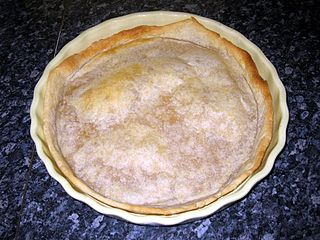
Shortcrust is a type of pastry often used for the base of a tart, quiche, pie, or flan. Shortcrust pastry can be used to make both sweet and savory pies such as apple pie, quiche, lemon meringue or chicken pie.

Baking is a method of preparing food that uses dry heat, typically in an oven, but can also be done in hot ashes, or on hot stones. The most common baked item is bread, but many other types of foods can be baked. Heat is gradually transferred "from the surface of cakes, cookies, and pieces of bread to their center, typically conducted at elevated temperatures surpassing 300°F. Dry heat cooking imparts a distinctive richness to foods through the processes of caramelization and surface browning. As heat travels through, it transforms batters and doughs into baked goods and more with a firm dry crust and a softer center. Baking can be combined with grilling to produce a hybrid barbecue variant by using both methods simultaneously, or one after the other. Baking is related to barbecuing because the concept of the masonry oven is similar to that of a smoke pit.

Pastry refers to a variety of doughs, as well as the sweet and savoury baked goods made from them. These goods are often called pastries as a synecdoche, and the dough may be accordingly called pastry dough for clarity. Sweetened pastries are often described as bakers' confectionery. Common pastry dishes include pies, tarts, quiches, croissants, and pasties.

A pie is a baked dish which is usually made of a pastry dough casing that contains a filling of various sweet or savoury ingredients. Sweet pies may be filled with fruit, nuts, fruit preserves, brown sugar, sweetened vegetables, or with thicker fillings based on eggs and dairy. Savoury pies may be filled with meat, eggs and cheese or a mixture of meat and vegetables.

An apple pie is a pie in which the principal filling is apples. Apple pie is often served with whipped cream, ice cream, custard or cheddar cheese. It is generally double-crusted, with pastry both above and below the filling; the upper crust may be solid or latticed. The bottom crust may be baked separately ("blind") to prevent it from getting soggy. Tarte Tatin is baked with the crust on top, but served with it on the bottom.

A mooncake is a Chinese bakery product traditionally eaten during the Mid-Autumn Festival (中秋節). The festival is primarily about the harvest while a legend connects it to moon watching, and mooncakes are regarded as a delicacy. Mooncakes are offered between friends or on family gatherings while celebrating the festival. The Mid-Autumn Festival is widely regarded as one of the four most important Chinese festivals.
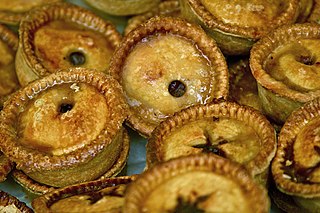
A pork pie is a traditional English meat pie, usually served either at room temperature or cold. It consists of a filling of roughly chopped pork and pork fat, surrounded by a layer of jellied pork stock in a hot water crust pastry. It is normally eaten as a snack or with a salad.

Hot water crust is a type of pastry used for savoury pies, such as pork pies, game pies, scotch pies and more rarely, steak and kidney pies. Hot water crust is traditionally used for producing hand-made pies.

A Scotch pie is a small, double-crust meat pie, traditionally filled with minced mutton but now generally beef, sometimes lamb. It may also be known as a shell pie to differentiate it from other varieties of savoury pie, such as the steak pie, steak and kidney pie, steak-and-tattie (potato) pie, and so forth. The Scotch pie originated in Scotland, but can be found in other parts of the United Kingdom and abroad.
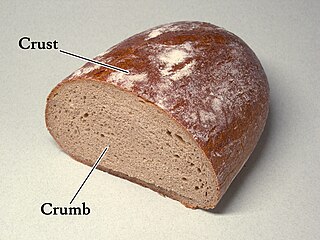
In baking, a crust is the outer, hard skin of bread or the shell of a pie. Generally, it is made up of at least shortening or another fat, water, flour, and salt. It may also include milk, sugar, or other ingredients that contribute to the taste or texture. An egg or milk wash can be used to decorate the outside, as well as coarse sugar. A crust contributes to a pastry.

Galette is a term used in French cuisine to designate various types of flat round or freeform crusty cakes, or, in the case of a Breton galette, a pancake made with buckwheat flour usually with a savoury filling. Of the cake type of galette, one notable variety is the galette des Rois eaten on the day of Epiphany. In French Canada the term galette is usually applied to pastries best described as large cookies.

Börek or burek is a family of pastries or pies found in Ottoman cuisine. The pastry is made of a thin flaky dough such as filo with a variety of fillings, such as meat, cheese, spinach, or potatoes. A borek may be prepared in a large pan and cut into portions after baking, or as individual pastries. They are usually baked but some varieties can be fried. Borek is sometimes sprinkled with sesame or nigella seeds, and it can be served hot or cold.

The following outline is provided as an overview of and topical guide to the preparation of food:
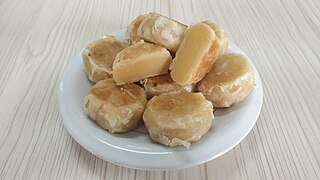
Bakpia or Hopia is a popular Indonesian and Philippine bean-filled moon cake-like pastry originally introduced by Fujianese immigrants in the urban centers of both nations around the past centuries. It is a widely available inexpensive treat and a favoured gift for families, friends and relatives.
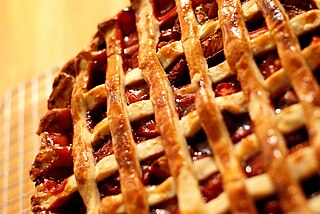
Lattice pastry is a pastry woven in a criss-crossing pattern of strips in the preparation of various foods. Latticed pastry is used as a type of lid on many various tarts and pies. The openings between the lattice allows fruit juices in pie fillings to evaporate during the cooking process, which can caramelize the filling.
Parbaking is a cooking technique in which a bread or dough product is partially baked and then rapidly frozen for storage or assembled into a final product. It has been used to increase the mass manufacture and distribution of bread products, including bagels.

A meat pie is a pie with a filling of meat and often other savory ingredients. They are found in cuisines worldwide.

A lemon tart is a dessert dish, a variety of tart. It has a pastry shell with a lemon flavored filling.

Buko pie, sometimes anglicized as coconut pie, is a traditional Filipino baked young coconut (malauhog) pie. It is considered a specialty in the city of Los Baños, Laguna located on the island of Luzon.

Pie in American cuisine evolved over centuries from savory game pies. When sugar became more widely available women began making simple sweet fillings with a handful of basic ingredients. By the 1920s and 1930s there was growing consensus that cookbooks needed to be updated for the modern electric kitchen. New appliances, recipes and convenience food ingredients changed the way Americans made iconic dessert pies like key lime pie, coconut cream pie and banana cream pie.




















